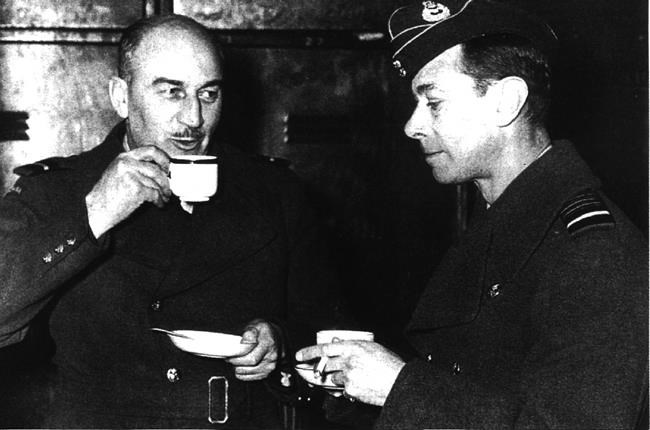First World War airmen from New Brunswick were pioneers of air warfare
By Hina Alam, The Canadian Press on November 9, 2024.
 Air Vice-Marshal Leigh Stevenson, left, drinks tea with King George VI in an undated handout archival photo. THE CANADIAN PRESS/HO-Harold Wright, *MANDATORY CREDIT*
Air Vice-Marshal Leigh Stevenson, left, drinks tea with King George VI in an undated handout archival photo. THE CANADIAN PRESS/HO-Harold Wright, *MANDATORY CREDIT*FREDERICTON – When pilots took to the air for combat during the First World War, it had been less than 15 years since the Wright brothers’ famous first flight in 1903. Aircraft were in the development stage, made of canvas over a wood frame and held together by something similar to piano wire.
“They were underpowered. They were quite flimsy, and if you happened to land heavily, sometimes they would be damaged,” said J. Brent Wilson, a historian who has just published “War Among the Clouds: New Brunswick Airmen in the Great War.”
Even training could be deadly for the pioneering pilots, he noted.
About 22,000 Canadians served in the British air services during the First World War, mostly from well-educated families in Ontario and Western Canada, Wilson said in a recent interview. But at least 252 were from New Brunswick, many from small farming communities.
They flew not just on the Western Front in France and Belgium, which was the main theatre of operations, but also around the Mediterranean and in Italy, Russia, Macedonia, Egypt and Palestine, Wilson said.
Wilson’s book draws on accounts of their service contained in letters home and in other records. He said he wanted to document the lives of airmen who came from rural New Brunswick. “I think it’s important that we remember that they made an important contribution to the wider war effort in defending the country,” Wilson said.
Tim Cook, chief historian at the Canadian War Museum, said that while flight was relatively new and initially exciting, it evolved during the war to include large-scale dogfights involving dozens of airmen who battled for control of the air.
While the “knights of the skies,” as the glamorous pilots were sometimes called, captured the attention of the public, he said, of greater importance to the armies on the ground, mired in the mud, were slower-moving observation aircraft. They photographed the front, providing crucial intelligence to commanders, gunners and infantry.
Wilson said one of the pilots he found most interesting was Maj. Albert Desbrisay Carter a graduate of Mount Allison University in Sackville, N.B. He was born in New Brunswick’s Westmorland County near Nova Scotia on July 3, 1892, and went on to become a Great War ace, Wilson said.
On Oct. 31, 1916, Carter shot down his first two planes, east of Ypres. In his combat report, detailed in the book, he describes the engagement.
“I dived on three enemy aircraft and picking out one, dived vertically on to it. I came to within 10 yards of it and had to pull out in order not to crash,” the report says. “I fired many bursts into the pilot’s and observer’s seats, starting from 150 yards until I had to pull out …. I could not see what happened to the enemy aircraft when we got near the ground; I finished off considerably under 1,000 feet.”
Over the course of the war, Carter shot down 28 German aircraft before being taken prisoner on May 19, 1918. The book narrates an account from one of Carter’s friends from Saint John, N.B., Capt. Stuart Bell, who recounted a conversation the two had. He described Carter demanding that British officers receive better treatment in German prison camps.
“To this, the German replied, ‘I will give you to understand that you are in Germany and you will do damned well as we tell you to,'” says the book.
“Maj. Carter’s reply to this was, ‘Yes, and that is the reason why the whole world is fighting you. You have no sense of honour or respect for conventions.’ For this, he received three days bread and water and cells.”
On May 22, 1919, the 27-year-old Carter, who had survived a bout of the Spanish flu, died during a training exercise when his plane crashed. He was buried at Old Shoreham Cemetery in England.
Another of the men detailed in the book is Lt. Alfred Belliveau of Fredericton. He began his pilot training at Shoreham in England on a two-seater Maurice Farman aircraft. His diary entries about the plane are documented in the book, writing they were “stable and easy to fly.” Belliveau went on to the top finishing school for fighter pilots at Turnberry, Scotland, where he practised stunt flying, says the book.
“We also did a lot of dogfighting in man-to-man aerial combat, but using cameras in place of machine-guns, the cameras being synchronized with the propeller blades like the machine-guns were, so as to enable us to take pictures of our opponent, through the whirling propellers, in the same manner as an actual combat with machine-guns,” says an entry from the pilot, as recorded in the book.
Wilson said New Brunswickers were a minority among the airmen, but they made an outsized contribution.
“We’d never had airplanes in wars before, so they were pioneers in this new form of warfare, and it had made very strong advances. … By the end of the war, from a technological point of view, aircraft and the role of the air forces had advanced very significantly.”
This report by The Canadian Press was first published Nov. 9, 2024.
21-20



Looking for exciting games and big wins? Visit Abo Casino in Australia. This online casino has collected the best slots, table games and live entertainment to satisfy the tastes of any player. Whether you like roulette, blackjack or slots, you will find everything you need for a great time here. Test your luck and enjoy the game in a safe and exciting environment.